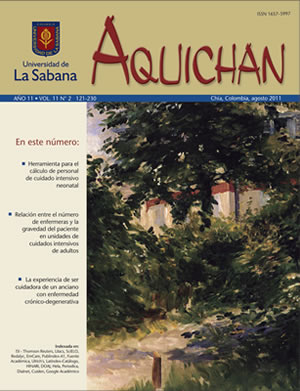Women’s Self-imposed Barriers to Timely Diagnosis and Treatment of Breast Cancer
Keywords:
Breast neoplasms, risk-taking, nursingAbstract
Objective: To describe the barriers that prevent women with breast cancer (BC) from seeking health care and adopting habits conducive to early detection and timely treatment. Materials and methods: This is a qualitative study based on grounded theory. The data were collected through semi-structured interviews with 13 women between 24 and 77 years of age who had been diagnosed with breast cancer. The interviews were conducted between 2006 and 2008 in Medellin, Colombia. Results: “Self-imposed barriers” are described, such as a fear of medical environments and treatment, delays in consulting a physician because work and family are considered a priority, and negative therapeutic experiences. Conclusions: The study shows “self-imposed barriers” prevent timely BC diagnosis and treatment. However, these barriers cannot be explained from a simplistic and isolated standpoint. Human beings are the result of their background, context, personal experiences and relationships with others. One of the main findings was the description of a process whereby women eventually develop a new logic concerning the risk of BC, specifically one that allows them to think about self-care and the care of others as subjects at risk.Downloads
Download data is not yet available.
Published
2011-08-29
How to Cite
Ceballos-García, G. J., & Giraldo-Mora, C. V. (2011). Women’s Self-imposed Barriers to Timely Diagnosis and Treatment of Breast Cancer. Aquichan, 11(2), 140–157. Retrieved from https://aquichan.unisabana.edu.co/index.php/aquichan/article/view/1897
Issue
Section
Articles
License
1. Proposed Policy for Journals That Offer Open Access
Authors who publish with this journal agree to the following terms:
- The journal and its papers are published with the Creative Commons License Attribution-NonCommercial-NoDerivatives 4.0 International (CC BY-NC-ND 4.0). You are free to share copy and redistribute the material in any medium or format if you: give appropriate credit, provide a link to the license, and indicate if changes were made; don’t use our material for commercial purposes; don’t remix, transform, or build upon the material.





